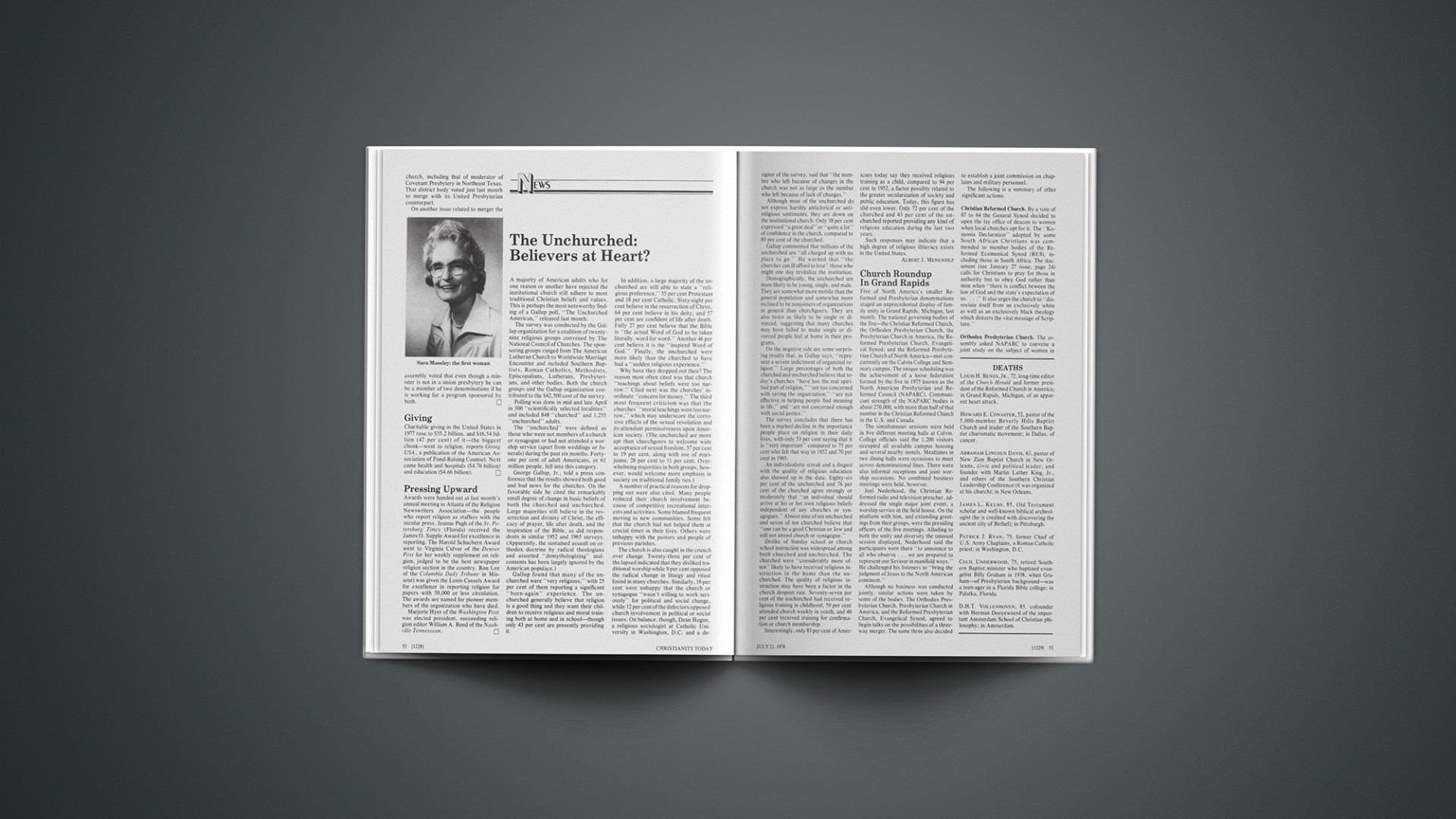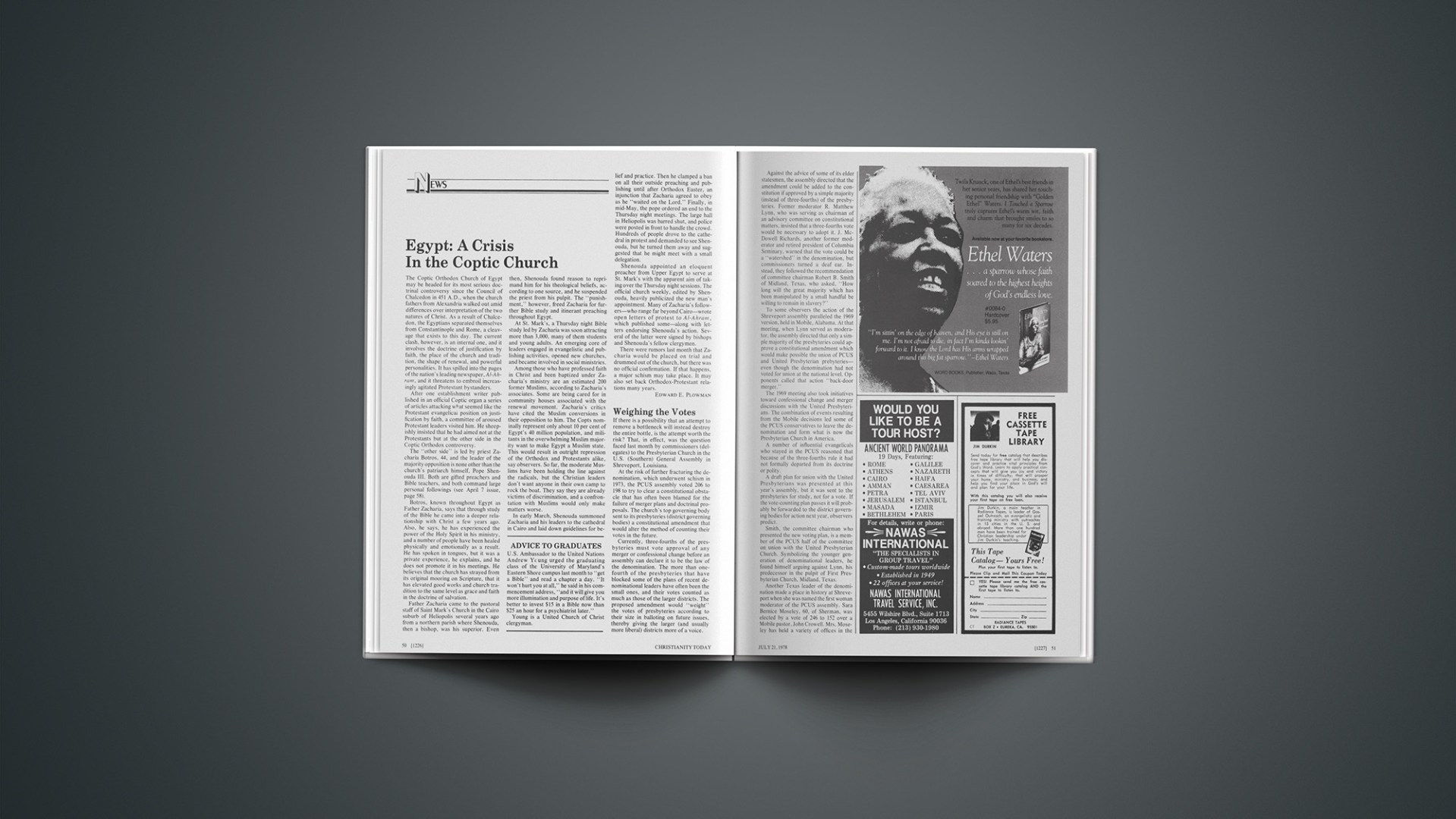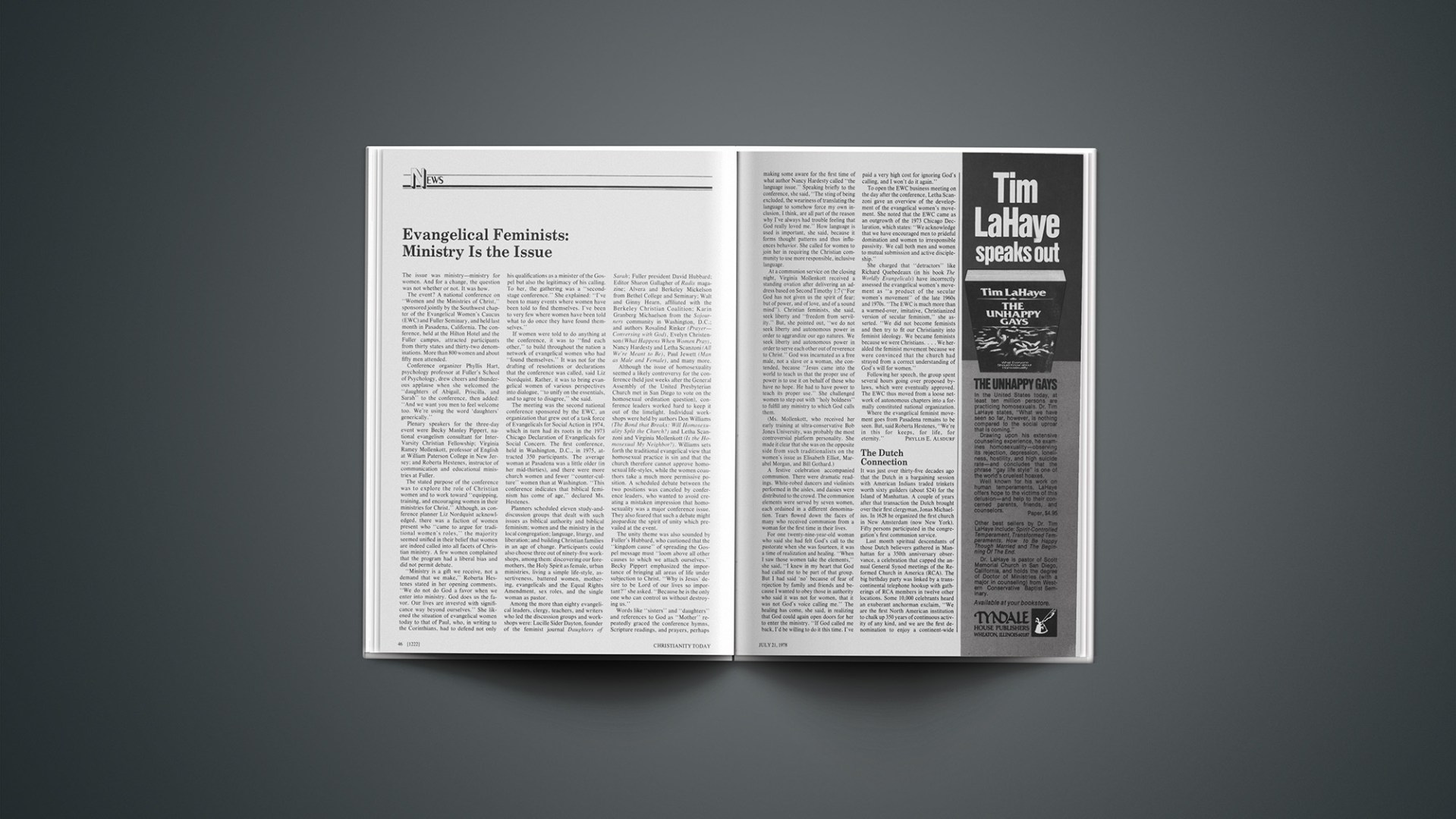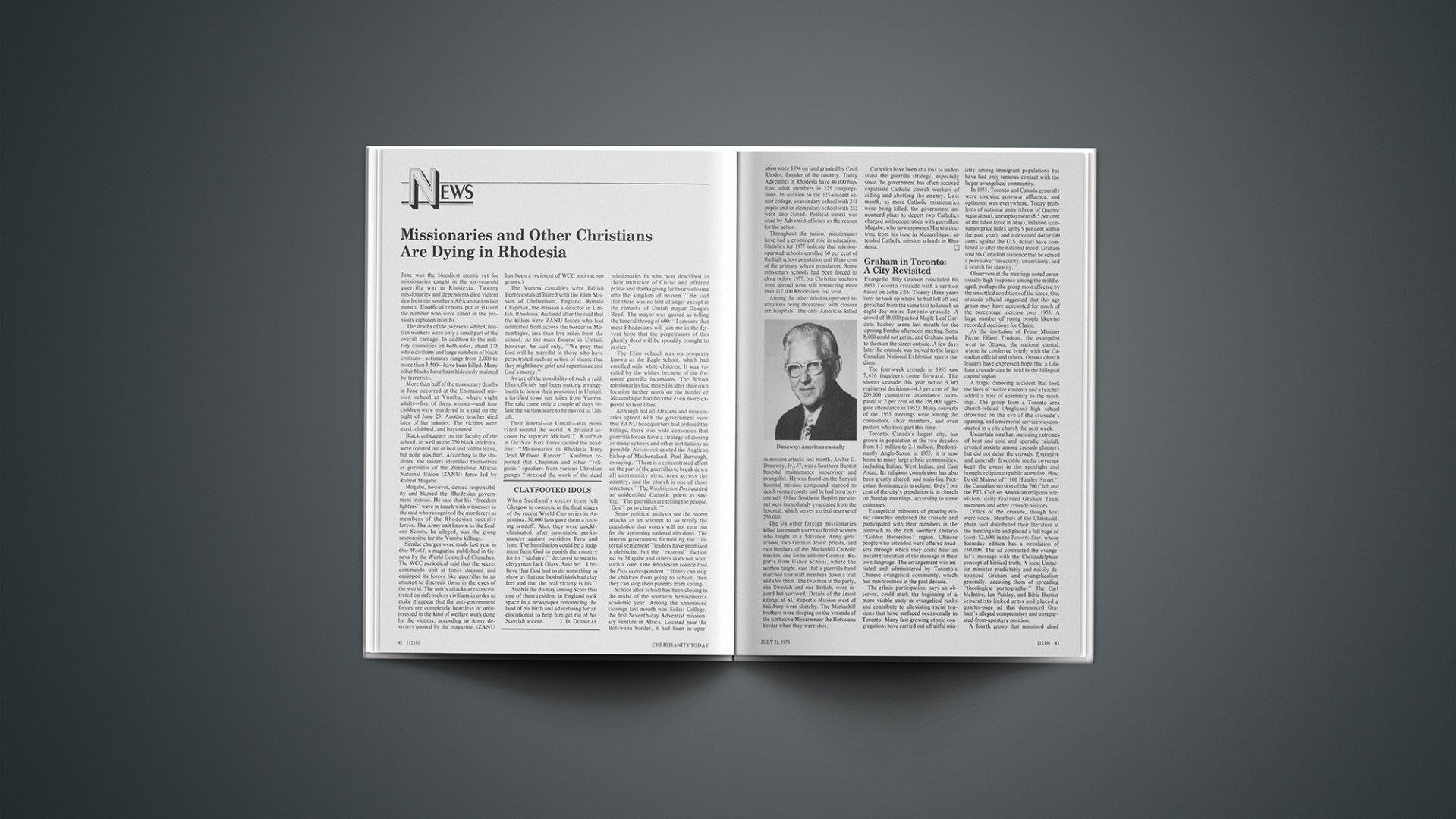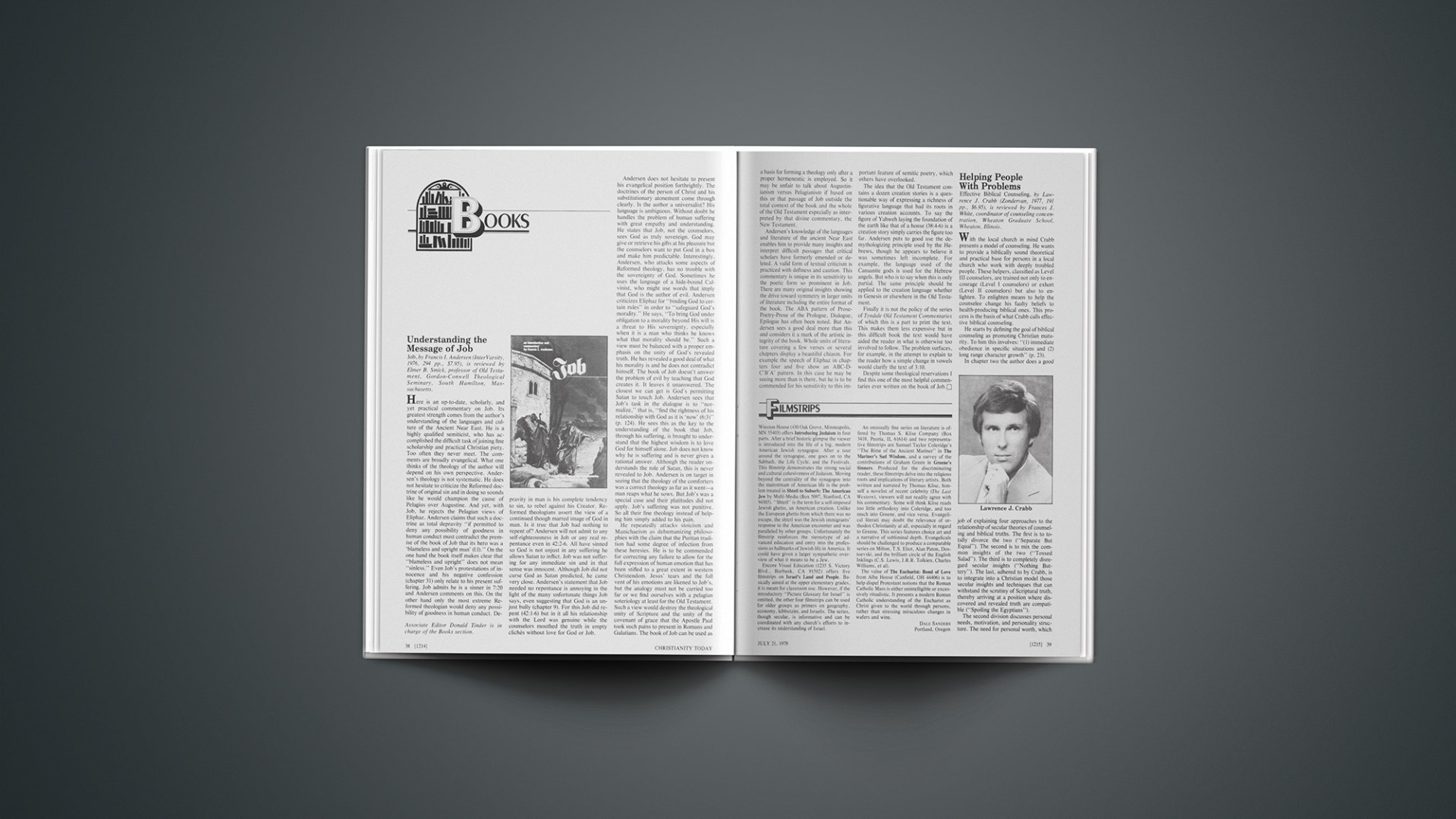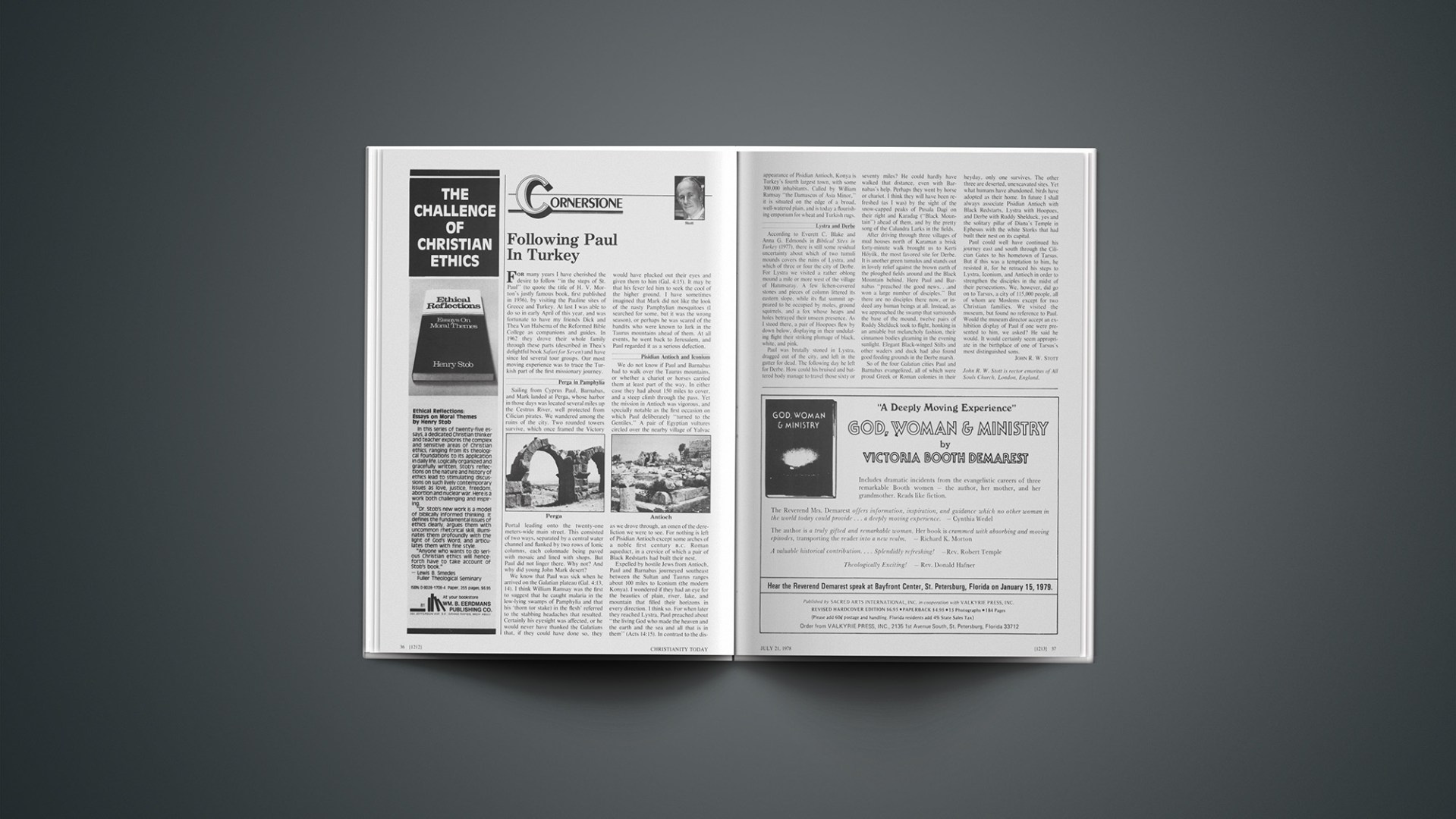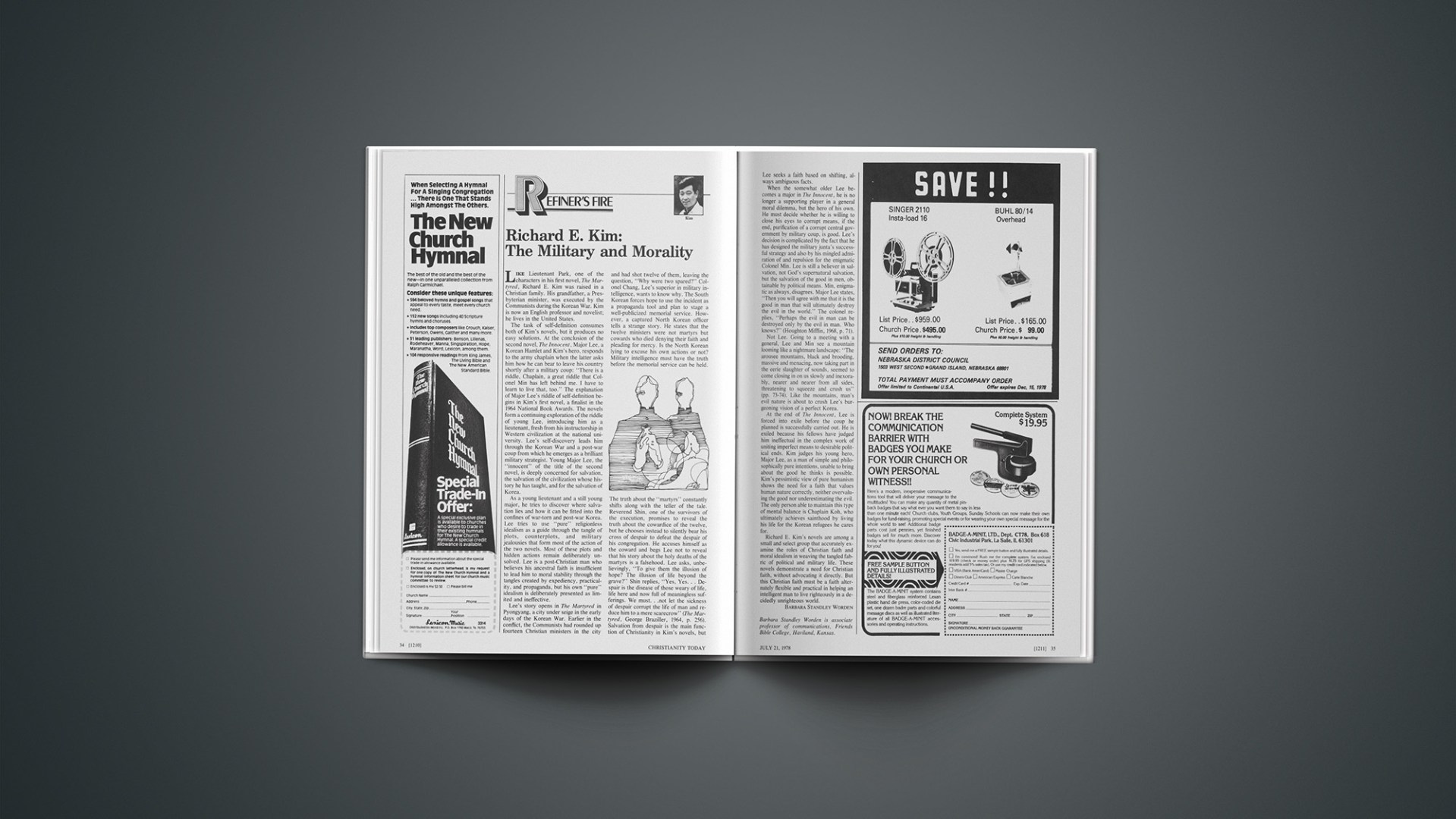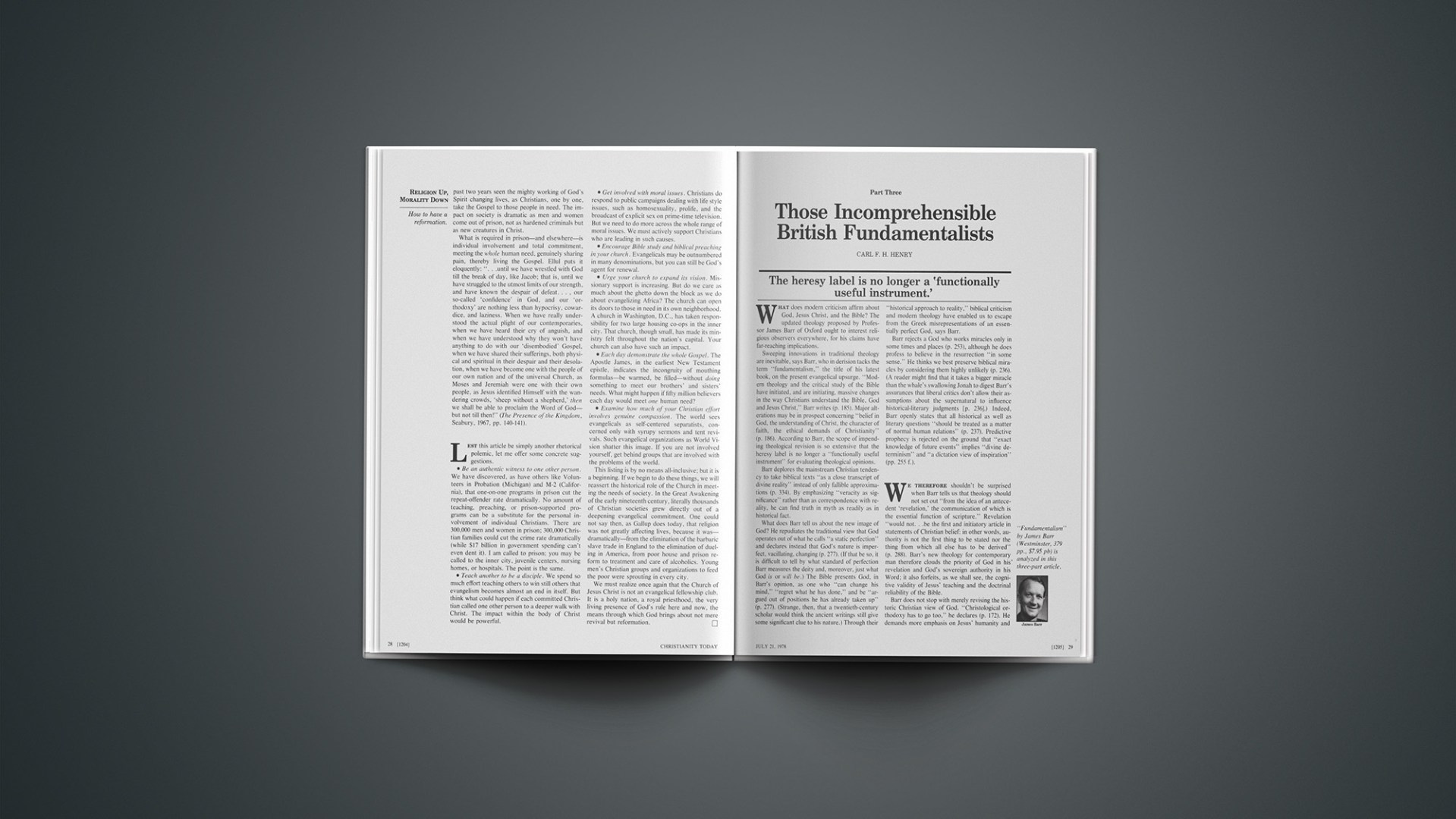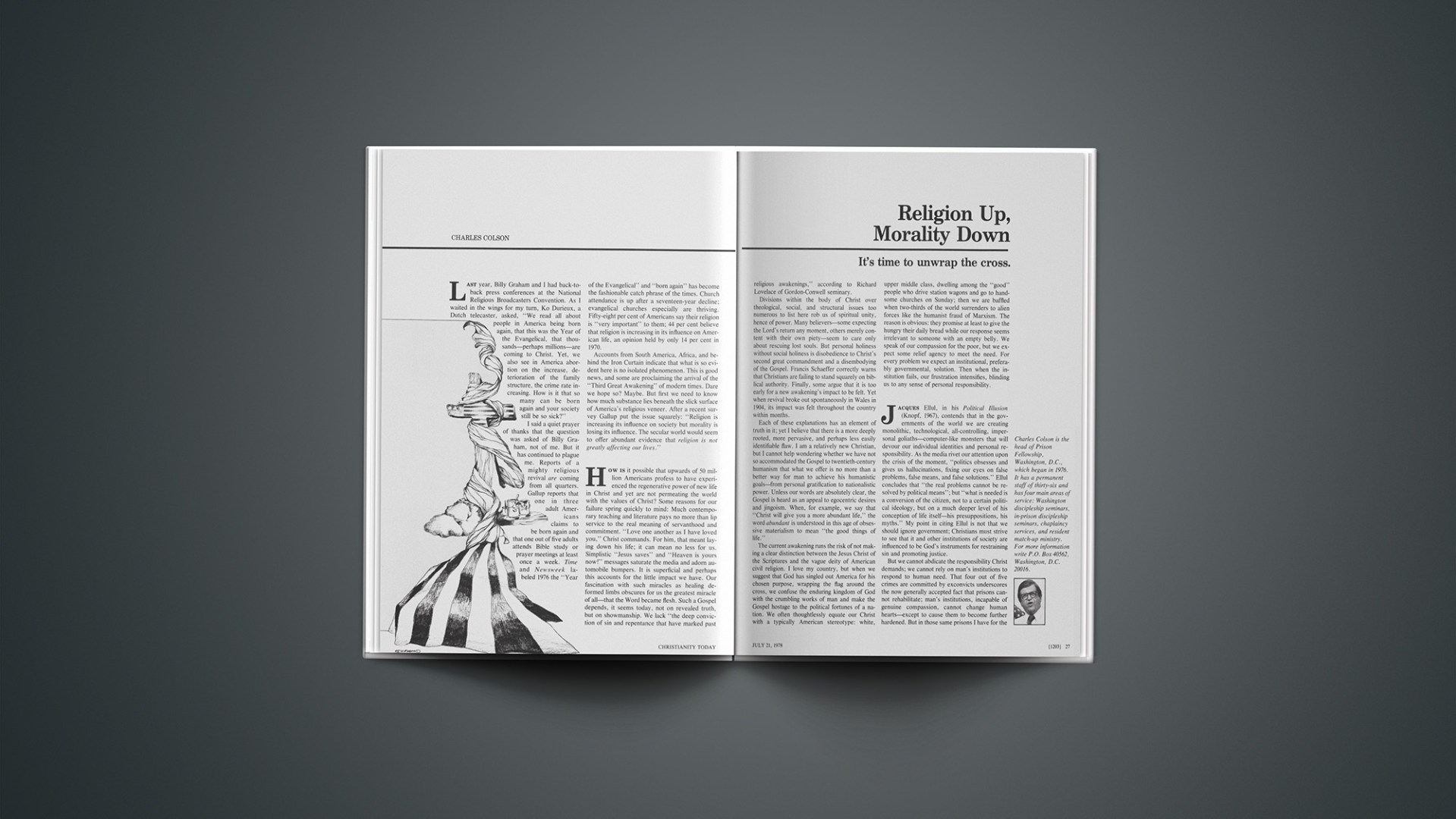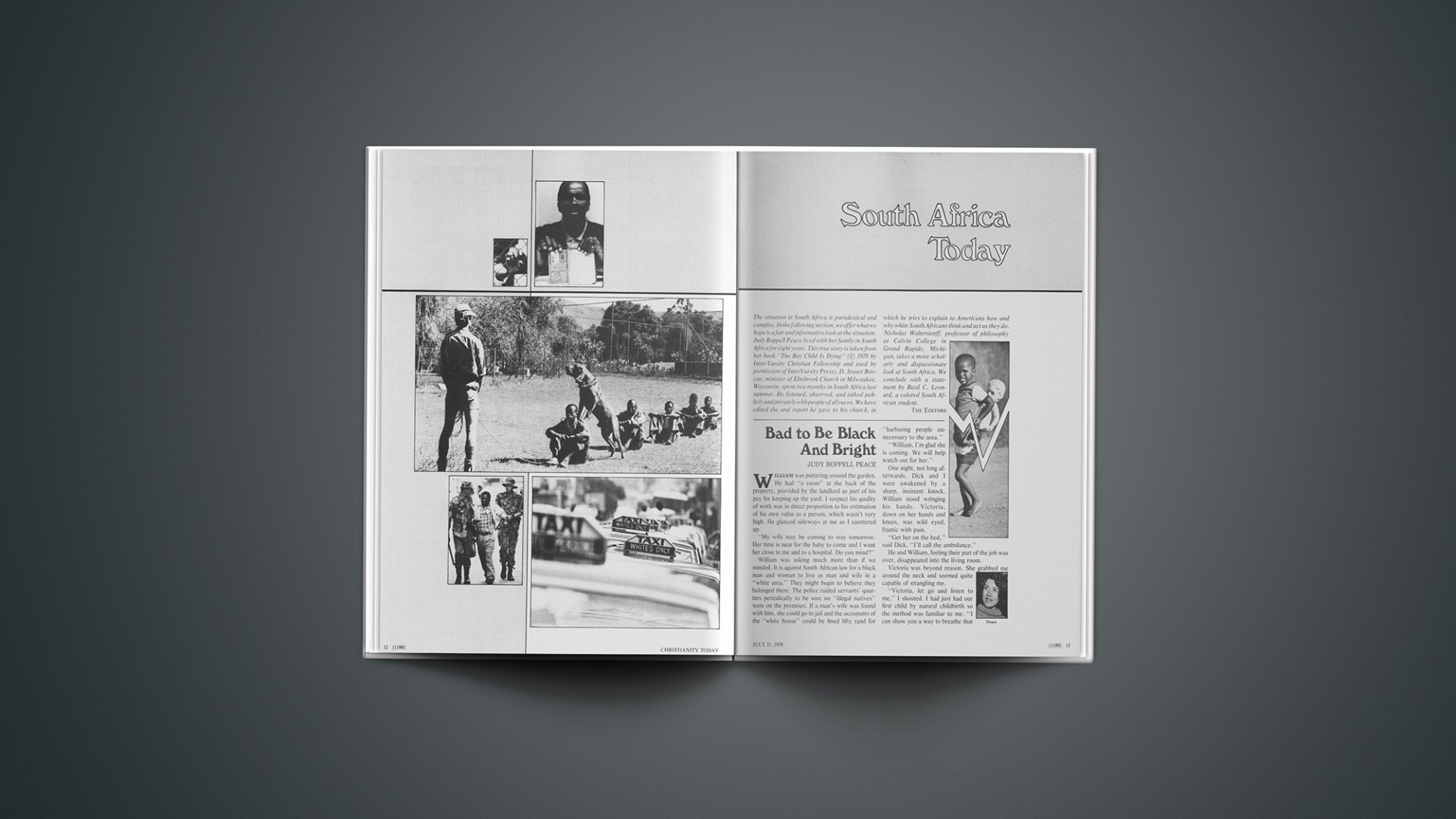A majority of American adults who for one reason or another have rejected the institutional church still adhere to most traditional Christian beliefs and values. This is perhaps the most noteworthy finding of a Gallup poll, “The Unchurched American,” released last month.
The survey was conducted by the Gallup organization for a coalition of twenty-nine religious groups convened by The National Council of Churches. The sponsoring groups ranged from The American Lutheran Church to Worldwide Marriage Encounter and included Southern Baptists, Roman Catholics, Methodists, Episcopalians, Lutherans, Presbyterians, and other bodies. Both the church groups and the Gallup organization contributed to the $42,500 cost of the survey.
Polling was done in mid and late April in 300 “scientifically selected localities” and included 848 “churched” and 1,255 “unchurched” adults.
The “unchurched” were defined as those who were not members of a church or synagogue or had not attended a worship service (apart from weddings or funerals) during the past six months. Forty-one per cent of adult Americans, or 61 million people, fell into this category.
George Gallup, Jr., told a press conference that the results showed both good and bad news for the churches. On the favorable side he cited the remarkably small degree of change in basic beliefs of both the churched and unchurched. Large majorities still believe in the resurrection and divinity of Christ, the efficacy of prayer, life after death, and the inspiration of the Bible, as did respondents in similar 1952 and 1965 surveys. (Apparently, the sustained assault on orthodox doctrine by radical theologians and assorted “demythologizing” malcontents has been largely ignored by the American populace.)
Gallup found that many of the unchurched were “very religious,” with 25 per cent of them reporting a significant “born-again” experience. The unchurched generally believe that religion is a good thing and they want their children to receive religious and moral training both at home and in school—though only 43 per cent are presently providing it.
In addition, a large majority of the unchurched are still able to state a “religious preference,” 55 per cent Protestant and 18 per cent Catholic. Sixty-eight per cent believe in the resurrection of Christ, 64 per cent believe in his deity, and 57 per cent are confident of life after death. Fully 27 per cent believe that the Bible is “the actual Word of God to be taken literally, word for word.” Another 46 per cent believe it is the “inspired Word of God.” Finally, the unchurched were more likely than the churched to have had a “sudden religious experience.”
Why have they dropped out then? The reason most often cited was that church “teachings about beliefs were too narrow.” Cited next was the churches’ inordinate “concern for money.” The third most frequent criticism was that the churches’ “moral teachings were too narrow,” which may underscore the corrosive effects of the sexual revolution and its attendant permissiveness upon American society. (The unchurched are more apt than churchgoers to welcome wide acceptance of sexual freedom, 37 per cent to 19 per cent, along with use of marijuana, 28 per cent to 11 per cent. Overwhelming majorities in both groups, however, would welcome more emphasis in society on traditional family ties.)
A number of practical reasons for dropping out were also cited. Many people reduced their church involvement because of competitive recreational interests and activities. Some blamed frequent moving to new communities. Some felt that the church had not helped them at crucial times in their lives. Others were unhappy with the pastors and people of previous parishes.
The church is also caught in the crunch over change. Twenty-three per cent of the lapsed indicated that they disliked traditional worship while 9 per cent opposed the radical change in liturgy and ritual found in many churches. Similarly, 16 per cent were unhappy that the church or synagogue “wasn’t willing to work seriously” for political and social change, while 12 per cent of the defectors opposed church involvement in political or social issues. On balance, though, Dean Hogue, a religious sociologist at Catholic University in Washington, D.C. and a designer of the survey, said that “the number who left because of changes in the church was not as large as the number who left because of lack of changes.”
Although most of the unchurched do not express harshly anticlerical or antireligious sentiments, they are down on the institutional church. Only 38 per cent expressed “a great deal” or “quite a lot” of confidence in the church, compared to 80 per cent of the churched.
Gallup commented that millions of the unchurched are “all charged up with no place to go.” He warned that “the churches can ill afford to lose” those who might one day revitalize the institution.
Demographically, the unchurched are more likely to be young, single, and male. They are somewhat more mobile than the general population and somewhat more inclined to be nonjoiners of organizations in general than churchgoers. They are also twice as likely to be single or divorced, suggesting that many churches may have failed to make single or divorced people feel at home in their programs.
On the negative side are some surprising results that, as Gallup says, “represent a severe indictment of organized religion.” Large percentages of both the churched and unchurched believe that today’s churches “have lost the real spiritual part of religion,” “are too concerned with saving the organization,” “are not effective in helping people find meaning in life,” and “are not concerned enough with social justice.”
The survey concludes that there has been a marked decline in the importance people place on religion in their daily lives, with only 53 per cent saying that it is “very important” compared to 75 per cent who felt that way in 1952 and 70 per cent in 1965.
An individualistic streak and a disgust with the quality of religious education also showed up in the data. Eighty-six per cent of the unchurched and 76 per cent of the churched agree strongly or moderately that “an individual should arrive at his or her own religious beliefs independent of any churches or synagogues.” Almost nine often unchurched and seven of ten churched believe that “one can be a good Christian or Jew and still not attend church or synagogue.”
Dislike of Sunday school or church school instruction was widespread among both churched and unchurched. The churched were “considerably more often” likely to have received religious instruction in the home than the unchurched. The quality of religious instruction may have been a factor in the church dropout rate. Seventy-seven per cent of the unchurched had received religious training in childhood, 59 per cent attended church weekly in youth, and 40 per cent received training for confirmation or church membership.
Interestingly, only 83 per cent of Americans today say they received religious training as a child, compared to 94 per cent in 1952, a factor possibly related to the greater secularization of society and public education. Today, this figure has slid even lower. Only 72 per cent of the churched and 43 per cent of the unchurched reported providing any kind of religious education during the last two years.
Such responses may indicate that a high degree of religious illiteracy exists in the United States.
Church Roundup In Grand Rapids
Five of North America’s smaller Reformed and Presbyterian denominations staged an unprecedented display of family unity in Grand Rapids, Michigan, last month. The national governing bodies of the five—the Christian Reformed Church, the Orthodox Presbyterian Church, the Presbyterian Church in America, the Reformed Presbyterian Church, Evangelical Synod, and the Reformed Presbyterian Church of North America—met concurrently on the Calvin College and Seminary campus. The unique scheduling was the achievement of a loose federation formed by the five in 1975 known as the North American Presbyterian and Reformed Council (NAPARC). Communicant strength of the NAPARC bodies is about 270,000, with more than half of that number in the Christian Reformed Church in the U.S. and Canada.
The simultaneous sessions were held in five different meeting halls at Calvin. College officials said the 1,200 visitors occupied all available campus housing and several nearby motels. Mealtimes in two dining halls were occasions to meet across denominational lines. There were also informal receptions and joint worship occasions. No combined business meetings were held, however.
Joel Nederhood, the Christian Reformed radio and television preacher, addressed the single major joint event, a worship service in the field house. On the platform with him, and extending greetings from their groups, were the presiding officers of the five meetings. Alluding to both the unity and diversity the unusual session displayed, Nederhood said the participants were there “to announce to all who observe … we are prepared to represent our Saviour in manifold ways.” He challenged his listeners to “bring the judgment of Jesus to the North American continent.”
Although no business was conducted jointly, similar actions were taken by some of the bodies. The Orthodox Presbyterian Church, Presbyterian Church in America, and the Reformed Presbyterian Church, Evangelical Synod, agreed to begin talks on the possibilities of a three-way merger. The same three also decided to establish a joint commission on chaplains and military personnel.
The following is a summary of other significant actions:
Christian Reformed Church. By a vote of 87 to 64 the General Synod decided to open the lay office of deacon to women when local churches opt for it. The “Koinonia Declaration” adopted by some South African Christians was commended to member bodies of the Reformed Ecumenical Synod (RES), including those in South Africa. The document (see January 27 issue, page 24) calls for Christians to pray for those in authority but to obey God rather than men when “there is conflict between the law of God and the state’s expectation of us.…” It also urges the church to “dissociate itself from an exclusively white as well as an exclusively black theology which distorts the vital message of Scripture.”
Deaths
LOUIS H. BENES, JR., 72, long-time editor of the Church Herald and former president of the Reformed Church in America; in Grand Rapids, Michigan, of an apparent heart attack.
HOWARD E. CONASTER, 52, pastor of the 5,000-member Beverly Hills Baptist Church and leader of the Southern Baptist charismatic movement; in Dallas, of cancer.
ABRAHAM LINCOLN DAVIS, 63, pastor of New Zion Baptist Church in New Orleans, civic and political leader, and founder with Martin Luther King, Jr., and others of the Southern Christian Leadership Conference (it was organized at his church); in New Orleans.
JAMES L. KELSO, 85, Old Testament scholar and well-known biblical archeologist (he is credited with discovering the ancient city of Bethel); in Pittsburgh.
PATRICK J. RYAN, 75, former Chief of U.S. Army Chaplains, a Roman Catholic priest; in Washington, D.C.
CECIL UNDERWOOD, 75, retired Southern Baptist minister who baptized evangelist Billy Graham in 1938, when Graham—of Presbyterian background—was a teen-ager in a Florida Bible college; in Palatka, Florida.
D.H.T. VOLLENHOVEN, 85, cofounder with Herman Dooyeweerd of the important Amsterdam School of Christian philosophy; in Amsterdam.
Orthodox Presbyterian Church. The assembly asked NAPARC to convene a joint study on the subject of women in the diaconate. Commissioners also reaffirmed Orthodox Presbyterian membership in the Reformed Ecumenical Synod and commended it to the Presbyterian Church in America and the Reformed Presbyterian Church Evangelical Synod. RES is an international federation of Calvinist denominations. One member, the Reformed Churches in the Netherlands, is also a member of the World Council of Churches and a contributor to its Program to Combat Racism. The dual loyalties has caused controversy within some other RES member bodies.
Presbyterian Church in America. Unconditional opposition to abortion was voted, and members were urged to work for legislation to protect the unborn. The assembly also voted to become a partner of the Reformed Presbyterian Church, Evangelical Synod, in the operation of Covenant College, Lookout Mountain, Tennessee.
Reformed Presbyterian Church Evangelical Synod. By a vote of 85 to 79 the General Synod sent to its presbyteries a proposal that would explicitly exclude women from the office of deacon.
Reformed Presbyterian Church of North America. The governing body of the group, known as the “Covenanters,” sent its lower judicatories a proposal to drop from ordination vows a question about public “covenanting [as] an ordinance of God to be observed by churches and nations.” Such covenanting has been a part of the denomination’s history since 1643.
ARTHUR H. MATTHEWS
Religion in Transit
Delegates to the Virginia Annual Conference of the United Methodist Church voted 765 to 533 to withdraw their year-old endorsement of the Equal Rights Amendment. The withdrawal was proposed by President Luther W. White III of Randolph-Macon College, who argued that state laws already assure equal rights for women. Fourteen clergywomen later issued a statement saying they were “deeply distressed by the action.” Many denominational and ecumenical groups are backing the ERA, and they are lobbying for an extension of the March, 1979, deadline for its ratification by the states.
The U.S. Census Bureau estimates that the U.S. population age 65 and older is expected to reach 31.8 million—12.2 per cent of the total population—by the year 2000.
A three-year study commissioned by the prestigious 1,100-member Catholic Theological Society (CTS) and conducted by three nuns and two priests concludes that there is no valid reason why women should not be ordained priests. The report, issued at the annual CTS meeting in Milwaukee last month, rejects arguments set forth in a 1977 Vatican declaration that reaffirmed an all-male priesthood.
Keep an eye on that lawsuit involving the Irvine, California, school district. The American Civil Liberties Union contends that it has violated constitutional provisions separating church and state by letting religious groups lease school facilities for their meetings. The action is “an attack on Christianity,” asserts pastor William D. Clancey of Believer’s Faith Center, which uses Irvine High School’s auditorium for Sunday services. Many congregations across the country meet in public school facilities. This arrangement could eventually be affected by the outcome of the Irvine case.
Girls younger than age 18 should have the right to get abortions without parental consent, the United Presbyterian Synod of the Northeast (New Jersey, New York, and New England) said in a resolution. About 1,000 delegates took part in the meeting.
General secretary Claire Randall of the National Council of Churches and priest-administrator Brian Hehir of the U.S. Catholic Conference were among the notables who accompanied President Jimmy Carter to Panama to witness post-ratification formalities involving the treaties that will turn over the Panama Canal and Canal Zone to Panama by the year 2000. Ms. Randall was chosen, explained an NCC aide, because a White House spokeswoman had said, “The National Council of Churches did as much as any single organization to achieve ratification of the treaties.”
The comeback trail is sometimes a bit steep. Only thirty-one people turned out in Wichita, Kansas, to hear evangelist Billy James Hargis, according to news reports. It was described as his first anticommunism rally in four years. In that time he has suffered health problems, troubles with the Internal Revenue Service, a split in his organization, and allegations in the national press of bisexual activities with students at the Tulsa college he formerly headed. Fund-raising appeals mailed by his organization paint a picture of dire financial need. Hargis, however, has told reporters that income has returned to normal levels and that his own health is better.
World Scene
Representatives of eight religious groups, including General Secretary Philip Potter of the World Council of Churches, joined with leaders of seventeen other international non-governmental organizations, in promoting disarmament before the United Nations General Assembly last month, the first time such organizations had been permitted a place at the assembly rostrum in an official meeting.
The General Assembly of the Presbyterian Church in Ireland, at a meeting in Dublin, voted 241 to 129 against a return of the death penalty in Northern Ireland.
A broadcast by the Ethiopian state radio last month said that hundreds of thousands of people are starving in the northeastern province of Wollo.
The African Inland Mission reports that its African Inland Church in six African nations now numbers more than 750,000 baptized believers in 5,000 churches that are served by nearly 1,000 pastors.
Since 1968, when it became independent from the Dutch Reformed Church of South Africa, the Reformed Church in Zambia has grown from 20,000 to 50,000 persons in thirty-eight congregations, according to a church news service report.
One of the world’s most famous masterpieces, Leonardo da Vinci’s “The Last Supper,” is being ravaged by mildew and will disappear unless urgent action is taken, a top Italian art curator warned last month. The chief culprit: Milan’s smog. Sulfur particles are interacting with the paints used by Leonardo in the 1490s, when he painted the scene on the interior wall of a Milan church. Other perils cited by the expert: increasingly heavy traffic outside the church, which may cause the wall to collapse, and changes in air quality inside caused by thousands of visitors.
Nearly 33,000 Bibles, more than half of them in a new translation, were recently purchased by Hungarians, thanks to a half-price sale sponsored by Hungary’s Protestant and Orthodox churches. Some 4,500 New Testaments were also snatched up in the sale, funded partly by the British-based United Bible Societies.
The United Church of Christ in the Philippines at its recent assembly went on record against one-man rule in the country, asked for an end to martial law, and called for “the immediate restoration of all the civil and political liberties of the citizens.”
The latest study by the Population Reference Bureau puts world population at 4.219 billion. Seven countries have more than 100 million people. In millions, they are: China, 930; India, 634.7; the Soviet Union, 261; the United States, 218.4; Indonesia, 140.2; Brazil, 115.4; Japan 114.4. (U.S. Census Bureau analyst John S. Aird says China’s population passed the one billion mark this spring.)

